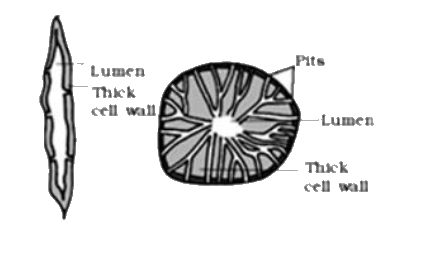Read the following statements:
I. Eukaryotic cell walls contain peptidoglycans in addition to cellulose.
II. Plasmodesmata and centrioles are found in all plant cells.
III. Plant cell contains 80s ribosomes which they use to manufacture proteins.
Iv. Amyloplasts are a type of plastids found in a plant cell that help so store carbohydrates.
Identify the statements that are INCORRECT regarding plant cell.
I and II only
I,II III and IV
II and IV only
I and III only
The correct Answer is:A
To solve the question, we need to analyze each statement regarding plant cells and identify which ones are incorrect.
Step 1: Analyze Statement I
- Statement I: "Eukaryotic cell walls contain peptidoglycans in addition to cellulose."
- Analysis: In plant cells, the cell wall is primarily composed of cellulose. Peptidoglycan is found in the cell walls of prokaryotes (like bacteria), not in eukaryotic cells. Therefore, this statement is incorrect.
Step 2: Analyze Statement II
- Statement II: "Plasmodesmata and centrioles are found in all plant cells."
- Analysis: Plasmodesmata are indeed present in plant cells and facilitate cell-to-cell communication. However, centrioles are not found in all plant cells; they are typically absent in higher plants (angiosperms). Thus, this statement is also incorrect.
Step 3: Analyze Statement III
- Statement III: "Plant cells contain 80s ribosomes which they use to manufacture proteins."
- Analysis: Plant cells, being eukaryotic, contain 80S ribosomes, which are involved in protein synthesis. This statement is correct.
Step 4: Analyze Statement IV
- Statement IV: "Amyloplasts are a type of plastids found in a plant cell that help to store carbohydrates."
- Analysis: Amyloplasts are indeed a type of plastid in plant cells that store starch, a carbohydrate. This statement is correct.
Conclusion: Identify Incorrect Statements
- The incorrect statements are:
- Statement I: Incorrect
- Statement II: Incorrect
- Statement III: Correct
- Statement IV: Correct
Thus, the statements that are incorrect regarding plant cells are I and II.
---
- Statement I: "Eukaryotic cell walls contain peptidoglycans in addition to cellulose."
- Analysis: In plant cells, the cell wall is primarily composed of cellulose. Peptidoglycan is found in the cell walls of prokaryotes (like bacteria), not in eukaryotic cells. Therefore, this statement is incorrect.
- Statement II: "Plasmodesmata and centrioles are found in all plant cells."
- Analysis: Plasmodesmata are indeed present in plant cells and facilitate cell-to-cell communication. However, centrioles are not found in all plant cells; they are typically absent in higher plants (angiosperms). Thus, this statement is also incorrect.
- Statement III: "Plant cells contain 80s ribosomes which they use to manufacture proteins."
- Analysis: Plant cells, being eukaryotic, contain 80S ribosomes, which are involved in protein synthesis. This statement is correct.
- Statement IV: "Amyloplasts are a type of plastids found in a plant cell that help to store carbohydrates."
- Analysis: Amyloplasts are indeed a type of plastid in plant cells that store starch, a carbohydrate. This statement is correct.
- The incorrect statements are:
- Statement I: Incorrect
- Statement II: Incorrect
- Statement III: Correct
- Statement IV: Correct
Similar Questions
Name the different types of plastids that may be found in plant cells. List their functions.
View SolutionSelect the wrong statements.
(i) All eukaryotic cells are identical.
(ii) All eukaryotic cells show compartmentalization.
(iii) Centrioles are absent in almost all plant cells.
(iv) Animal cells contain no larger central vacuoles.
View Solution
Knowledge Check
Which carbohydrate is found in the cell walls of plants ?
AStarchBChitinCCelluloseDGlycogen
Assertion:- All eukaryotic cells are not identical.
Reason:- Centrioles are found in animal cells, absent in almost all plant cell.
View SolutionGiven type of plant cells are found in all of the following , except

View SolutionName the following:
The cell organelles which are found only in the plant cell.
View SolutionRead the following statements regarding the ciliated epithelium .
I. Found only in the lining of the trachea .
II cilia are found on the free surface of the cells.
III Help in moving particles or mucus in a particular direction over the epithelium.
IV Microvilli are found at the free end to increase the surface area of the organ.
identify the ones that are correct .
View SolutionRead the following statements below.
I. All the carbon compounds that we get from living tissues can be called ‘biomolecules.
II. The ash formed after burning a tissue contains inorganic and organic substances. .
III. Beta amino acids are used by the cells to form proteins. .
Identify the true and false statements.
View SolutionWhich parts of a cell contain ribosomes ?
I. Chloroplast
II. Mitochondrion
III. Nucleus
IV. Cytoplasm
View SolutionState whether the statement are true (T) or false (F):
Plant cells contain large vacuoles.
View Solution
